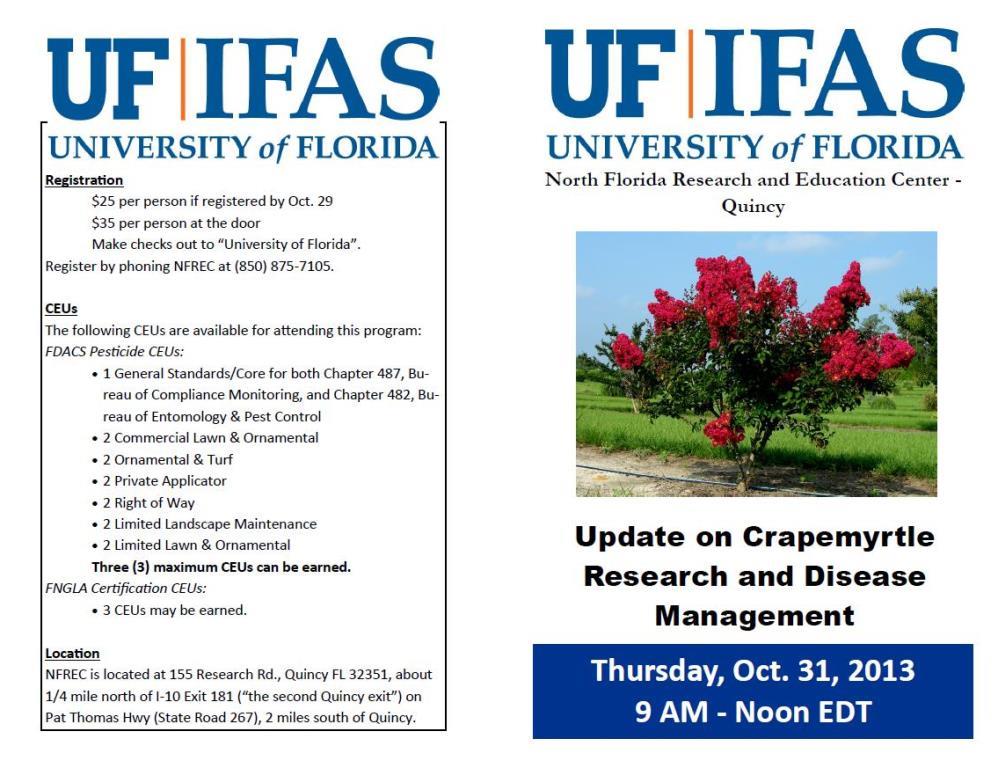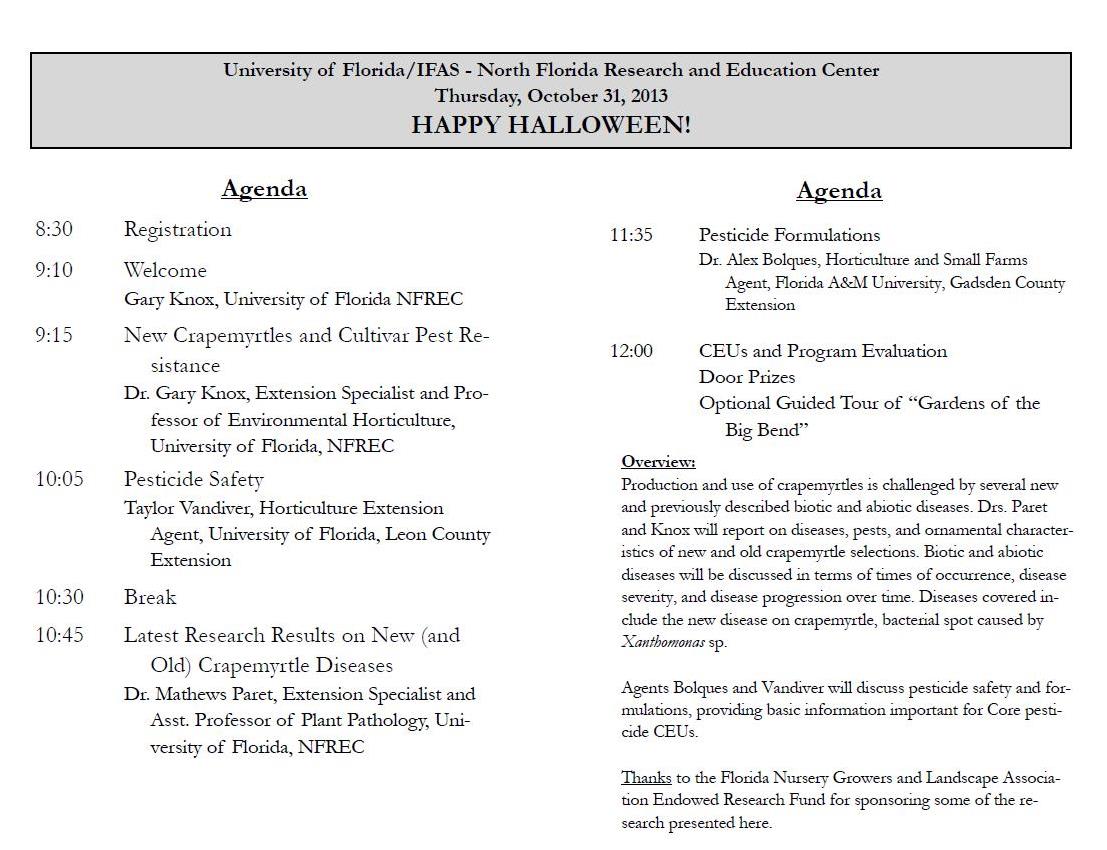by Matthew Orwat | Jan 7, 2014
On the night of January 6-7th 2014 Northwest Florida was hit with a major freeze event. While many areas reached 18 º F, the West Florida Research & Education Center near Jay reached 14 º F. Similar freezing temperatures are predicted for the night of January 7-8.
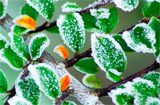
Frosted plant. Image Credit UF IFAS Extension
Strategies for ornamental plant protection before, during, and after freeze events:
- Water: Your best friend is water because well watered soil retains more heat, and a well watered plant has less chance of drying out during an advective freeze (freeze caused by cold air mass, with wind).
- Move containerized plants indoors, especially tropical or subtropical plants, annuals or herbs. Containerized woody ornamental shrubs can be left outside, but place them in a sheltered area or south-facing side of a structure.
- When covering sensitive plants, including row covers for vegetable gardens, the covers should extend to the ground. This allows the heat from the soil to radiate within the covered area. Light bulbs or strings of lights help extend the protection covered plants. Be sure to remove covers when temperatures warm, since covers will trap excessive heat during warm periods.
- After the freeze event, water the plant well. Plants lose water through transpiration after freeze events and may not be able to take up water as readily if root damage occurred. This will also help thaw the soil of exposed containerized plants.
For additional information, check out this UF IFAS page on Freeze Protection of Ornamental Plants
Here are some protection tips specific to the home citrus garden:
- Generally, satsuma are cold tolerant down to 15° F, but young trees or trees yet to achieve dormancy are usually only tolerant to 26°F. Fruit should not sustain damage from freezing temperatures above 25°F. In fact, temperatures between 25°F and 35°F enhance the sweetness of the fruit.
- Extreme winds sometimes make the effects of freeze events worse if the trees are not well watered. A well hydrated tree is a well protected tree. On the whole, still nights make for worse freeze events since cold air will “settle” into low areas.
- Wrap the trunk with commercial tree wrap or mound soil around the base of the tree up to 2 feet. This will protect the graft of the young tree. Thus, if the branches freeze the graft union will be protected.
- For established citrus trees, mound soil around the tree in a cone formation. Do not mulch the trees over the winter since heat that radiates up from the soil will be blocked somewhat by mulch.
- Young trees (those under 6 feet tall) can be covered the tree with a cloth sheet or blanket. For additional protection, large bulb Christmas lights can be placed around the branches of the tree. This will increase the temperature under the cover by several degrees. Be sure to use outdoor lights and outdoor extension cords to avoid the potential of fire.
- Always remember to remove cold protection once the temperature rises so that the trees do not overheat.
- Do not cover trees with plastic tarp, these will not protect the tree and can “cook” the tree once the sun comes out.
- Water citrus trees. Well watered trees have increased cold hardiness. Do not over-water. If the ground is moist, it is not necessary to water.
- Frames may be installed around young trees to hold the cover. This option keeps the blanket or sheet from weighing down the branches.
- Micro-irrigation is an option. This practice will protect citrus trees up to 5 feet, but must be running throughout the entire freeze event. It needs to be turned on at 36ºF and left on until the temperature reached 42 ºF. If the tree is too large for complete coverage, the emitter should be located on the windy side of the tree. Be sure that the water covers the graft union, since most trees will recover from any freeze if the union is not damaged. For additional information read this publication on micro-sprinkler irrigation.
- Kumquats are the most cold tolerant citrus type grown in Northwest Florida, so protection of fruit is not required unless freeze events reach 20°F. Established tree can withstand colder temperatures without protection.
For additional information, contact your local extension office.
by Matthew Orwat | Dec 9, 2013
Looking for the perfect Christmas tree to celebrate your Holidays? Join Wendy Wilber, UF/IFAS Extension Alachua County Environmental Horticultural Agent, as she offers tips on finding and preserving your fresh-cut Christmas tree throughout the Holiday Season.
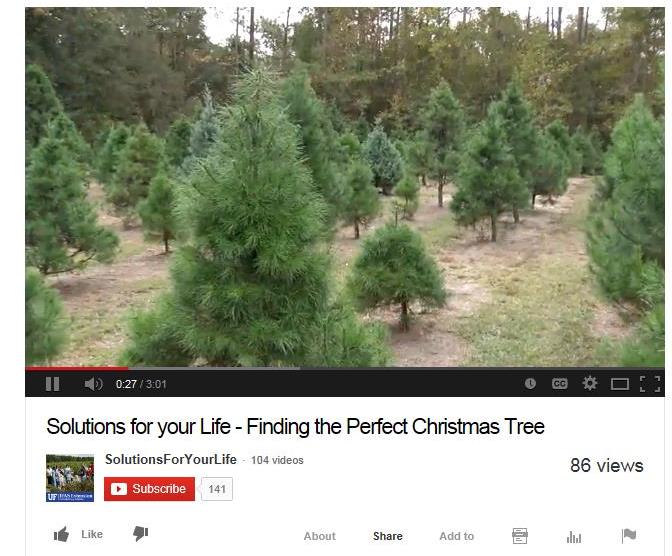
by Matthew Orwat | Nov 18, 2013
On the night of November 13th, a mild freeze of 30°F occured in parts of Northwest Florida. Don’t be caught without a citrus protection plan !
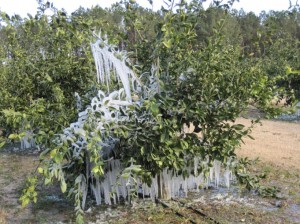
Satsuma Tree protected with micro-irrigation. Image Credit: UF IFAS Jackson County Extension
How cold does it have to get before citrus in Northwest Florida needs to be protected? A concrete answer to this question does not exist. Growers and home gardeners alike must consider several factors including type of citrus grown and the location of the citrus.
Below are a few quick facts to assist growers and home gardeners in determining whether to protect or not to protect their citrus:
- Certain citrus trees such as lime, pomelo, grapefruit, sweet orange, lemon and citron will definitely need protection or need to be moved into a sheltered area. Individuals that grow these types on a consistent basis either wrap their trees with protective covers each season or grow them in containers and move them into greenhouses.
- The meyer lemon, which is in reality a lemon-sweet orange hybrid, is a tree that was introduced to the united states in 1908. Mature dormant meyer lemons can be hardy down to 20°F, with fruit hardy to 26°F. Immature trees, or those that have not reached dormancy, should be protected. Covers made of cloth should be large enough to touch the ground so that heat from the soil can help keep the tree warm.
- Generally, satsuma are cold tolerant down to 15° F, but young trees or trees yet to achieve dormancy are usually only tolerant to 26°F. Fruit should not sustain damage from freezing temperatures above 25°F. Extreme winds sometimes make the effects of freeze events worse, so it is always better to err on the side of protection if the trees are planted in an exposed site.
- Kumquats are the most cold tolerant citrus type grown in Northwest Florida, so protection is not required unless freeze events reach 20°F.
Additional facts to assist the grower or home gardener with citrus protection:
- Plant trees on a south-facing slope, south of windbreaks, on the south side of a structure or under a light canopy if possible. South facing slopes block harmful cold winds. Structures offer radiant heat which aids in the protection of citrus trees. Additionally, light over-story pine canopies allow sufficient sunlight through while reducing frost damage.
- Wrap the trunk with commercial tree wrap or mound soil around the base of the tree up to 2 feet. This will protect the graft of the young tree. Thus, if the branches freeze the graft union will be protected.
- Cover the tree with a cloth sheet or blanket. For additional protection, large bulb Christmas lights can be placed around the branches of the tree. This will increase the temperature under the cover by several degrees. Be sure to use outdoor lights and outdoor extension cords to avoid the potential of fire.
- Water citrus trees. Well watered trees have increased cold hardiness. Do not over-water. If the ground is moist, it is not necessary to water.
- Frames may be installed around young trees to hold the cover. This option keeps the blanket or sheet from weighing down the branches.
- For large production areas, micro-irrigation is an option. This practice will protect citrus trees up to 5 feet, but must be running throughout the entire freeze event. For additional information read this publication on micro-sprinkler irrigation.
- Always remember to remove cold protection once the temperature rises so that the trees do not overheat.
- Do not cover trees with plastic tarp, these will not protect the tree and can “cook” the tree once the sun comes out.
For additional information, contact your local extension office.
by Matthew Orwat | Oct 23, 2013

Image Credit: UF IFAS EDIS
From Dr. John P. Hayes”
“Florida Crossroads made a 28 minute video entitled “Seeds of Change” featuring the IFAS breeding efforts to create new varieties of blueberries, strawberries, tomatoes, and other crops, and the ways that these programs have influenced Florida industry.
For those of you who are familiar with our breeding programs, you’ll enjoy seeing some of our scientists on the screen. For those who aren’t familiar with IFAS development of new varieties, it is well worth the watch and I’d encourage you to do so. Our breeding program and the scientists engaged in breeding at UF are world class.”






